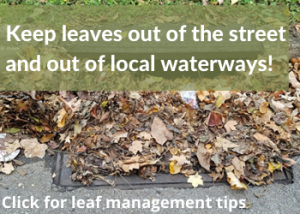Restoration project brings the native Illinois prairie back to southeast Bloomington
By Carl Roberts, EAC Volunteer
Native prairie within Bloomington city limits
Driving east on Ireland Grove Road, past the airport and Towanda Barnes Road, you will see hundreds of beautiful, new homes that have popped up in the last five years. You might exclaim how this was farmland the last time you drove through the area, and how Bloomington-Normal is growing so rapidly.
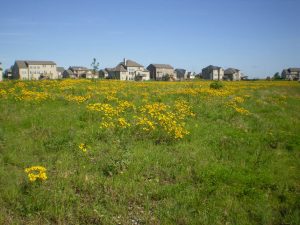
The homes in the Grove on Kickapoo Creek are built around acres of beautiful wildflowers and natural vegetation. Photo by David Lamb.
The remarkable significance of this area is not the new homes, however. It’s the 450 acres of native Illinois prairie that has been restored in the center of the Grove on Kickapoo Creek subdivision. This is one among only a small handful of similar projects throughout the nation that is restoring native wetlands as a means of naturally controlling storm water and preserving the land.
The prairie sure beats an artificial, empty lake
A new real-estate subdivision is frequently built around a rectangular area that looks like an empty lake. When rainstorms come, the rainwater rushes through the streets and empties into this area, making it an actual lake. The water has to go somewhere, and emptying it into a lake certainly beats having flooded streets and water pouring into people’s basements.
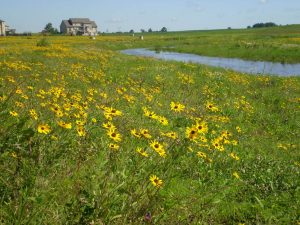
A number of curves in the creek slow down the water, which prevents erosion and flooding. Photo by David Lamb.
The firm designing the new subdivision, the Farnsworth Group, had to meet strict storm water detention codes. Water detention is different from retention, which means to hold the water in place. Water detention is the process of slowing down the water to prevent flooding and erosion, and causing the water to pass through the area at a normal rate.
The water detention plan developed for the Grove on Kickapoo Creek subdivision was considerably different from the artificial-lake plan that is frequently used. The Farnsworth Group designers and City of Bloomington Engineering Department worked together to create a plan for controlling the storm water through all-natural means by restoring the land to its original condition as a prairie.
How to plan a prairie
Restoring farmland into its native state as a prairie is not easy or cheap. The Farnsworth Group and Bloomington engineers were able to succeed in this task because of the involvement of several ecological experts from organizations including the Illinois Environmental Protection Agency, Illinois Department of Natural Resources, United States Geological Survey and Natural Resources Conservation Service. The $1.77 million project was primarily funded by a U.S. Environment Protection Agency grant.
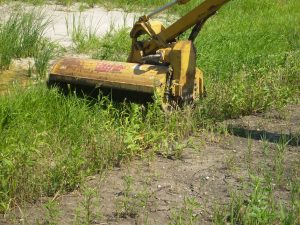
Restoring the land to its original condition as a prairie required careful planning and a lot of hard work. Photo by David Lamb.
Before work on the prairie restoration could begin, Bloomington’s water and sewage pipes had to be extended for 1.5 miles to reach the new subdivision. Being part of the city’s water and sewage systems was critical for providing the future residents with clean water and ensuring that the sewage from the future homes did not contaminate the water in Kickapoo Creek or the surrounding prairie.
Two creek branches re-meandered to create wetlands
The land most suitable for restoring the prairie turned out to be where two small branches of the Kickapoo Creek join together to form one, larger creek. The water in the two creek branches was channeled back into the meandering, curving flow of water that would have passed through the original prairie. By placing rocks in the water to slow and direct it and planting natural prairie vegetation along the banks, the designers and engineers were able to restore the natural wetlands that originally existed where the creek branches came together.
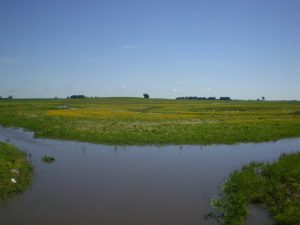
The project was built in the location where two small branches of the Kickapoo Creek converge to form one, larger creek. Photo by David Lamb.
The wetlands provide a significant benefit in cleaning the water before the two creek branches come together. Water carrying excess nitrates and phosphorous from nearby farming flow into the creek branches, causing environmental concerns. The nitrates and phosphorous are cleaned out of the water by nature. Bacteria in the wetland sediments consume some of the nitrates and release them into the atmosphere as nitrogen gas. Plants in the water absorb some of the nitrogen and phosphorous as well, thus reducing them from the water.
The City of Bloomington has confirmed that the water cleansing by the wetlands is effective. They established monitoring stations along each branch of the streams at the beginning of the wetlands, along their path through the wetlands, and where they come together after the wetlands. The water samples from the monitoring stations show an average decrease in nitrates and phosphorous of 20 percent to 50 percent.
Pedestrian bridge along Kickapoo Creek
A pedestrian bridge was built across the creek at the point where the two branches converge into one. The bridge provides a fun, easy way for hikers to cross the creek, beautiful scenery for people driving on Ireland Grove Road, and an all-natural barrier to control the water converging into Kickapoo Creek.
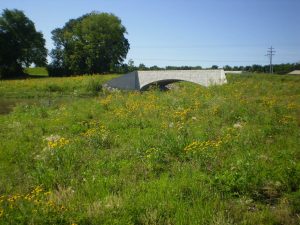
The pedestrian bridge serves an important role during rainstorms in holding back the flood of water. Photo by David Lamb.
The pedestrian bridge has a relatively small opening through which the water flows. During heavy rainfall, the sturdy, concrete bridge holds back the rush of water and allows a steady, restricted amount of water to flow into Kickapoo Creek. This prevents flooding, erosion of the stream’s banks, and clogging the creek downstream with sediment.
The rush of water held back by the bridge is temporarily deflected into the wetlands located before the two branches of the creek come together. As the water level in the creek goes down following the rainstorm, the deflected water flows from the wetlands back into the creek at a safe and moderate rate. Kickapoo Creek eventually empties into the Sangamon River.
A natural place to live
Where there are wetlands, wildlife will come. Many types of wild vegetation, animals, fish, birds and butterflies have been spotted in the wetlands. Miles of trails built through the area provide the residents of the homes with scenic locations for hiking, biking, bird watching, fishing and playing. The subdivision also includes a park and Benjamin Elementary School.
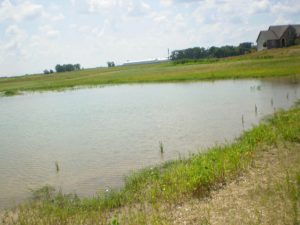
Water from heavy rainfall is temporarily deflected into the wetlands where the two branches of the creek come together. Photo by David Lamb.
The “Friends of Kickapoo Creek” and “Grove on Kickapoo Creek Homeowners Association” are groups of citizens who watch over this unique subdivision. The City of Bloomington Parks and Recreation Department provides the maintenance necessary to keep the creek, wetlands and prairie in their natural state.




